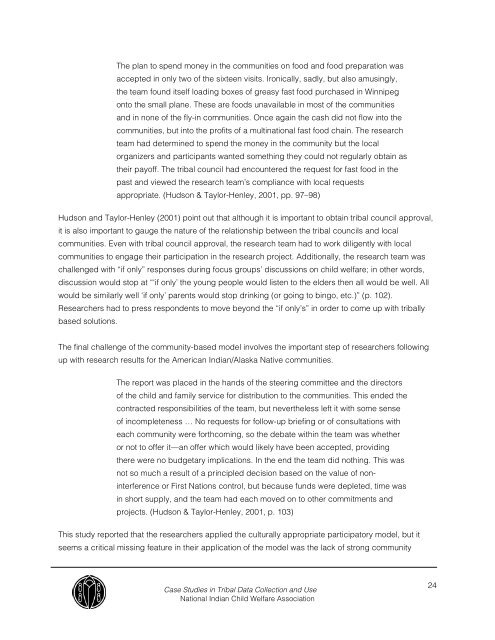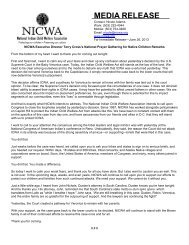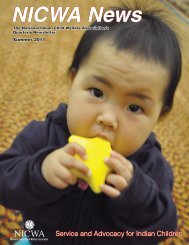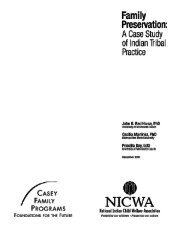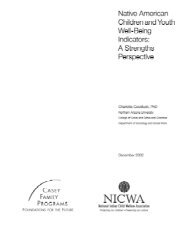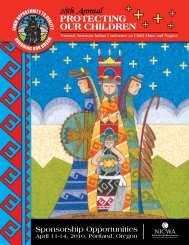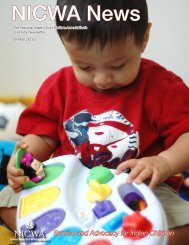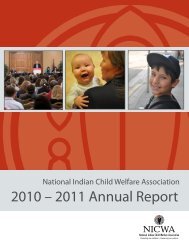case studies in tribal data collection and use - National Indian Child ...
case studies in tribal data collection and use - National Indian Child ...
case studies in tribal data collection and use - National Indian Child ...
Create successful ePaper yourself
Turn your PDF publications into a flip-book with our unique Google optimized e-Paper software.
The plan to spend money <strong>in</strong> the communities on food <strong>and</strong> food preparation wasaccepted <strong>in</strong> only two of the sixteen visits. Ironically, sadly, but also amus<strong>in</strong>gly,the team found itself load<strong>in</strong>g boxes of greasy fast food purchased <strong>in</strong> W<strong>in</strong>nipegonto the small plane. These are foods unavailable <strong>in</strong> most of the communities<strong>and</strong> <strong>in</strong> none of the fly-<strong>in</strong> communities. Once aga<strong>in</strong> the cash did not flow <strong>in</strong>to thecommunities, but <strong>in</strong>to the profits of a mult<strong>in</strong>ational fast food cha<strong>in</strong>. The researchteam had determ<strong>in</strong>ed to spend the money <strong>in</strong> the community but the localorganizers <strong>and</strong> participants wanted someth<strong>in</strong>g they could not regularly obta<strong>in</strong> astheir payoff. The <strong>tribal</strong> council had encountered the request for fast food <strong>in</strong> thepast <strong>and</strong> viewed the research team’s compliance with local requestsappropriate. (Hudson & Taylor-Henley, 2001, pp. 97–98)Hudson <strong>and</strong> Taylor-Henley (2001) po<strong>in</strong>t out that although it is important to obta<strong>in</strong> <strong>tribal</strong> council approval,it is also important to gauge the nature of the relationship between the <strong>tribal</strong> councils <strong>and</strong> localcommunities. Even with <strong>tribal</strong> council approval, the research team had to work diligently with localcommunities to engage their participation <strong>in</strong> the research project. Additionally, the research team waschallenged with “if only” responses dur<strong>in</strong>g focus groups’ discussions on child welfare; <strong>in</strong> other words,discussion would stop at “‘if only’ the young people would listen to the elders then all would be well. Allwould be similarly well ‘if only’ parents would stop dr<strong>in</strong>k<strong>in</strong>g (or go<strong>in</strong>g to b<strong>in</strong>go, etc.)” (p. 102).Researchers had to press respondents to move beyond the “if only’s” <strong>in</strong> order to come up with <strong>tribal</strong>lybased solutions.The f<strong>in</strong>al challenge of the community-based model <strong>in</strong>volves the important step of researchers follow<strong>in</strong>gup with research results for the American <strong>Indian</strong>/Alaska Native communities.The report was placed <strong>in</strong> the h<strong>and</strong>s of the steer<strong>in</strong>g committee <strong>and</strong> the directorsof the child <strong>and</strong> family service for distribution to the communities. This ended thecontracted responsibilities of the team, but nevertheless left it with some senseof <strong>in</strong>completeness … No requests for follow-up brief<strong>in</strong>g or of consultations witheach community were forthcom<strong>in</strong>g, so the debate with<strong>in</strong> the team was whetheror not to offer it—an offer which would likely have been accepted, provid<strong>in</strong>gthere were no budgetary implications. In the end the team did noth<strong>in</strong>g. This wasnot so much a result of a pr<strong>in</strong>cipled decision based on the value of non<strong>in</strong>terferenceor First Nations control, but beca<strong>use</strong> funds were depleted, time was<strong>in</strong> short supply, <strong>and</strong> the team had each moved on to other commitments <strong>and</strong>projects. (Hudson & Taylor-Henley, 2001, p. 103)This study reported that the researchers applied the culturally appropriate participatory model, but itseems a critical miss<strong>in</strong>g feature <strong>in</strong> their application of the model was the lack of strong communityCase Studies <strong>in</strong> Tribal Data Collection <strong>and</strong> Use<strong>National</strong> <strong>Indian</strong> <strong>Child</strong> Welfare Association24


